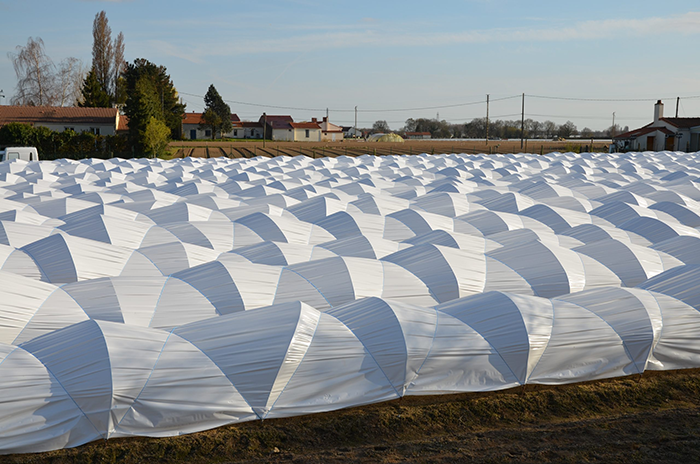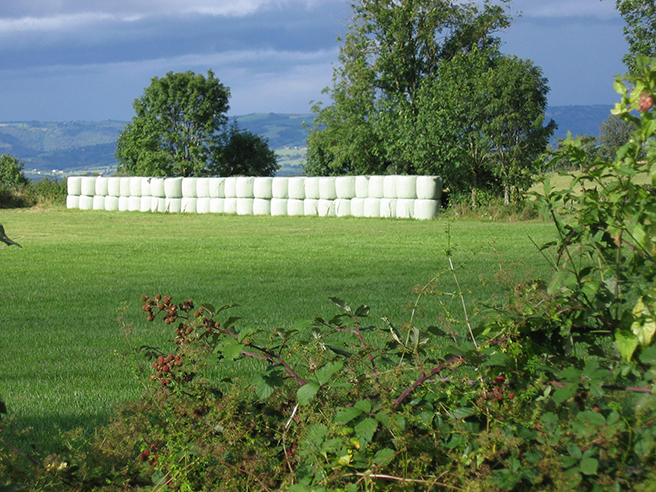Our aim: to recover all end-of-life agricultural plastics

APE, which stands for Agriculture Plastics & Environment, is a European association: can you tell us about its objectives?
APE is an association comprised of different companies and organisations involved in agricultural plastics (or agri-plastics), not including packaging. Our sphere of operation predominantly concerns the various mulch, greenhouse and silage films, protective nets and twine. We definitely aim to defend and promote the use of agricultural plastics, which are excellent levers for improving agricultural quality and yield. However, our main objective is to set up national collection chains to recycle these plastics throughout Europe. In other words, the aim is to establish a European strategy for the sustainable use of plastics in agriculture, thus reducing the environmental impact of agricultural production.

|
The interest in using plastics in agricultural practices can seem counter-intuitive. Is it really necessary?
Well, we could manage without them, but we simply wouldn’t achieve the same yield, and production would immediately drop by 60%. This would make feeding a growing population complicated. However, something else that’s really important to note is that agricultural plastics also make a positive ecological impact in that the crops that benefit from them require fewer fertilisers, fewer agricultural inputs, less water and, most importantly, less energy since it’s not always necessary to heat the greenhouses. Pointing the finger at plastics is often oversimplifying matters…
How much agricultural plastic is used in Europe?
Around 720,000 tons per year, which is approximately 1.5% of the overall demand for plastics. Three polymers make up nearly 99% of all agricultural plastics: polypropylene and high and low-density polythenes.

|
The recycling techniques for these materials are fairly well mastered, regardless of whether the plastics are enriched with additives to make them more flexible, more opaque or more robust. Biobased or biodegradable polymers such as PLA or PBAT (polybutylene adipate terephthalate) are predominantly used in twine or mulch films that biodegrade in the soil. While they’re not the most widely used plastics, we are seeing a consistent increase in their usage. |
So, these polymers are simple to recycle… but is it easy to set the sector up efficiently?
Unfortunately not… to put it simply, there are two main agricultural plastic families: the first is intended for silaging, greenhouse coverings or bales. Although they have a long lifespan (a year or more), they have little or no contact with the soil, unlike the second family: mulch films and flat tarpaulins. While the nature of their polymers is quite similar, they usually become contaminated with minerals, soil and water after use. They also have a short lifespan, typically weeks or months — the time it takes for a crop to reach maturity.
|
The fact these films become contaminated is where the issue lies. Once used, they can weigh up to four times more than their original weight. Many recyclers refuse to accept these films because the time it takes to clean them impacts their profitability, sometimes even making them completely unprofitable. We set up our own process twenty years ago, and the products collected were exclusively recycled in Europe. |

|
However, the Chinese authorities put a very serious brake on plastic waste imports in 2013 and 2016, refusing to play the role of “recycler” for other countries. As a result, European recyclers have had to absorb the quantities previously processed in Asia (3 million tonnes), which are reputed to be inexpensive to process and relatively uncontaminated. Consequently, European recyclers turned away from agricultural films that didn’t fit these characteristics.
We’ve had to completely rethink our industry, using R&D to improve the quality1 of agricultural plastics to make them acceptable to the recycling industry again. In the meantime, we’ve returned to a practice that we’d prefer to have forgotten: landfill. This is the fate of 10,000 tonnes of end-of-life plastic in France alone. However, it’s worth noting that energy recovery is also an option. Northern European countries have been doing this with agricultural plastics for a while. However, southern Europe tends to favour mechanical recycling. This is particularly frustrating considering that France in particular had organised the sector very well; it was deemed the example to follow. Though with that being said, that’s still the case today.
1 See waste reduction at source programme: RAFU and biodegradable
What impact has this Chinese measure had on collection?
Collection is a necessity for farmers who need to dispose of their used plastics to make room to store new crops. Volumes collected and collection rates continued to increase even after China imposed restrictions on plastic waste imports.
What are the current collection rates?
That depends on three things: the age of the program and regional organisation, the volume per farm, and opportunities for reuse. The rate varies from 25 to 95%, with an overall average reaching 70% after 5 years. At the individual level, the collection of used plastics is predominantly a service for farmers, and they’ll use it if it’s accessible, economically advantageous, and there are no alternative solutions. Collection operators such as Adivalor in France or RIGK in Germany are therefore developing tools adapted to local needs: collection systems, regional coverage, collection points, mobile or combined collection, collection bags, support at collection points, digital apps... the possibilities are pretty much endless and will depend on the specific area in question.
|
At the collective level, all EU Member States must support the implementation of dedicated collection schemes if they are to achieve the European Commission’s objectives and respond to the environmental challenge. In some countries, these targets have already been exceeded (Ireland, Sweden, France...). Based on this, the agri-plastics industry is mobilised and ready. |

|
How are your processes organised?
They’re organised differently in different countries. For example, France, Sweden and Ireland are a few steps ahead while Germany’s schemes are still in their infancy, and the UK is in the start-up phase. As such, it’s hard to generalise at a European level. In any case, our processes rely on the entire value chain and community involved in agricultural plastics: polymer producers, agricultural plastic manufacturers, farmers, of course, and recyclers. Considering the whole value chain is important because the decisions made by one element within the chain have an impact on the rest. But, with time and experience, I think we’ve reached a European model that centres farmers because they’re ultimately the main users of the service. The national collection schemes issue good practice sheets, which we send to agriculture professionals. These have been very well received as farmers are tired of being perceived as polluters despite their efforts to make their agricultural practices more sustainable. Some of these good practices were met with a smile, such as sweeping soil off of used films. Once we explained that films needed to be as clean as possible in order to be recycled, they soon understood and were happy to carry out the task, even if it meant extra work.

|
So, farmers are on board. Are they interested in the design of new agricultural plastics?
Yes, they’re on the lookout for new products and are very interested in films with recycled content. This is definitely one of the reasons why they’re so involved, as we’ve previously mentioned. There are a lot of recycled films on the market today, and silage films in particular have been a huge hit. We’re also starting to see stretch films made from recycled polymers appear on the market, intended to protect haystacks and bales. Such films are not yet possible for greenhouses because they can require a lifespan of 3 to 5 years and, most importantly, cannot become opaque during this time, and recycled material doesn’t allow for this at the moment. Farmers are also interested in biodegradable plastics such as PBAT, a copolyester. This is of particular interest when it comes to mulch films because it biodegrades directly into the soil. All farmers have to do is bury it by turning the soil, and it will degrade within a few months.

|
Farmers are also very aware of their energy consumption, whether that’s for agricultural machinery or heating greenhouses. Research to develop a greenhouse film that incorporates flexible photovoltaic panels is well underway, something that would be a considerable step forward. We hope to see the first applications of this technology soon as the research is advancing well. |
So, the future is pretty promising?
Absolutely, though right now, we’re focused on the present. Biodegradable or biobased film usage is growing well, but this won’t solve everything. Our goal is still the same: to stop agricultural plastics from ending up in the environment. Contrary to popular belief, agri-plastics are vital to the success of the Green Deal, a programme launched by the European Commission in 2019 which aims to make agriculture more sustainable by using fewer agricultural inputs, for example. Remember, growing vegetables under a film means fewer pesticides, fewer herbicides and less water... All we need to do now is find a solution for end-of-life agricultural plastics. We’ve made this our mission and intend to complete it no later than 2030 by proposing collection and recycling solutions for all agri-plastics. The shared governance model is a major step forward, providing the greatest technical and economic efficiency.

|
Learn more:
https://apeeurope.eu/welcome-to-agriculture-plastic-environment-ape-europe/





